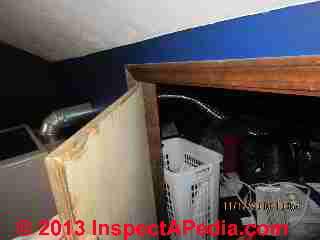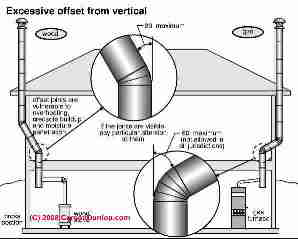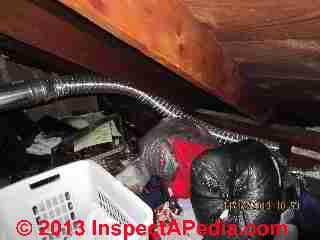 Metal Chimney & Vent Indoor Hazards
Metal Chimney & Vent Indoor Hazards
- POST a QUESTION or COMMENT about metal chimney defects and safety problems that can be detected by an inspection of the building interior
Metal chimney flue fire hazards:
This article describes various metal chimney & vent hazards which can be detected indoors in buildings: unsafe fire clearances, improper chimney slope, wrong materials, metal flues which are not continuous and excessive angular offset in metal chimneys, making them clog-prone and difficult to clean.
Other indoor damage or hazards involving metal chimneys include mechanical damage, rust, and improper installation.
InspectAPedia tolerates no conflicts of interest. We have no relationship with advertisers, products, or services discussed at this website.
Metal Chimney & Vent Indoor Hazards
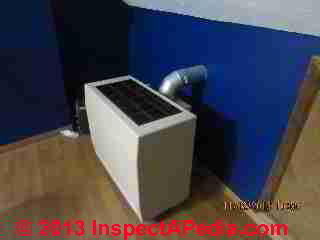 Un-Licensed to Kill: An Example of a Dangerous Metal Chimney & Gas Appliance Venting Installation
Un-Licensed to Kill: An Example of a Dangerous Metal Chimney & Gas Appliance Venting Installation
The buyer of a commercial strip plaza with 2 apartments above was required to obtain an inspection of the apartments only by the bank.
Normally commercial properties are not always required to have a pre-purchase building inspection, but this lender demanded that at least the rental apartments be inspected. That decision may have just saved some lives.
The seller purchased and installed a [used] gas fired radiant heater from a second hand outlet.
The unit was installed by the seller, who did not pull permits, did not get an inspection by city officials or the fire dept, and did not install C/O detectors in the rental units, as required by law since 2006.
See details at CO DETECTION OPTIONS
and CO ALARM CAUSES
The heating unit was installed with single wall vent pipe, through a wall without the required wall thimble that prevents contact with combustibles. [Photos above]
The vent pipe enters attic space [below left], this requires double wall pipe to prevent condensation, and not only was there no double wall pipe, the installer used metal flex pipe and he went down out the soffit instead of up through the roof.
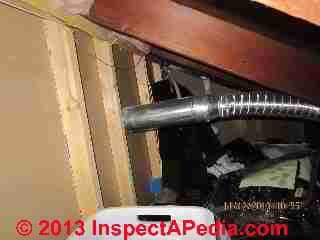

The vent pipe was in direct contact with old dried balloon framing [photo above right], with personal storage, and clothes. When I observed the set up I was stunned.
I made it very clear that this heating unit is a very dangerous set up and can very easily cause a fire, and deadly carbon monoxide levels to accumulate.
See details at FIRE CLEARANCES INDOORS
The unit should be disconnected, and installed by a licensed heating contractor.
More questions about this gas heater installation
In addition there appears to be an immediate and lethal carbon monoxide hazard. We are guessing from the photos that this unit vents by natural draft. That is, there is no power vent.
But look at the slope on the metal chimney running through the attic: it slopes down rather than up - if this is natural-draft heating equipment there will be no draft - a condition that produces dangerous carbon monoxide that can quickly prove lethal.
See details at CARBON MONOXIDE - CO
We also had a question about the flue vent materials; if aluminum material was used there are additional hazards and code violations.
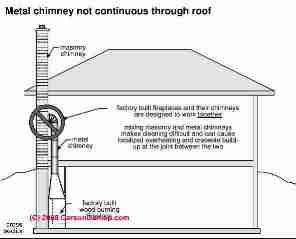 David Grudzinski, Advantage Home Inspections,
ASHI cert # 249089, HUD cert# H-145, is a professional home inspector who contributes on various topics including structural matters. Mr. Grudzinski, Cranston RI serving both Rhode Island and Eastern Connecticut can be reached at 401-935-6547 fax- 401-490-0607 or by email to Davidgrudzinski@aol.com. Mr. Grudzinski is a regular contributor to InspectAPedia.com - see DECK FLASHING LEAKS, ROT Case Study, and BASEMENT WATER MOLD IMPACT and VERMICULITE INSULATION for examples.
David Grudzinski, Advantage Home Inspections,
ASHI cert # 249089, HUD cert# H-145, is a professional home inspector who contributes on various topics including structural matters. Mr. Grudzinski, Cranston RI serving both Rhode Island and Eastern Connecticut can be reached at 401-935-6547 fax- 401-490-0607 or by email to Davidgrudzinski@aol.com. Mr. Grudzinski is a regular contributor to InspectAPedia.com - see DECK FLASHING LEAKS, ROT Case Study, and BASEMENT WATER MOLD IMPACT and VERMICULITE INSULATION for examples.
Metal Chimneys Must be Continuous
Carson Dunlop's sketch shows a metal chimney that is not continuous from the heating appliance up through the roof.
An installer may install a metal flue through only part of the building, deliberately as shown in the sketch, thinking that the heat from the indoor section of the metal chimney will give extra heat to the upstairs in the building.
The result is a hybrid chimney with two flues which are offset from one another.
Not only is it difficult to clean these hybrid flues but the risk of creosote build-up and a chimney fire is increased.
Excessive Offset from Vertical in Metal Chimneys
Carson Dunlop Associates [at REVIEWERS] sketch below shows a metal chimney that has excessive offset in it travel upwards between the heating appliance and the roof.
The allowed angular offset in a chimney is as much as 60 degrees in some but not all jurisdictions.
As with our description of discontinuous metal chimneys above, a concern is with creosote build-up n the elbows and also in the sloped section of the chimney.
Look for evidence of corrosion or creosote leakage at the joints.
Details are at CREOSOTE FIRE HAZARDS
Check with your local building code and fire officials about the chimney offset angles allowed in your area.
Reader Comments, Questions & Answers About The Article Above
Below you will find questions and answers previously posted on this page at its page bottom reader comment box.
Reader Q&A - also see RECOMMENDED ARTICLES & FAQs
Question: wood stove chimney clearance clarification
(Aug 23, 2014) Dino said:
Wood stove requires 27 inches between vent pipe and combustable. Does that require the pipe from the roof through the ceiling have that clearance or can it be closer and use elbows to get out to the 27 inch? It will be at least 18 inches away from the wall at the cathedrial ceiling.
Reply:
Dino,
You'll want to use a "zero clearance" ( which may mean one-inch) insulated metal chimney for passing through combustible materials such as ceilings, walls, roofs. Check with your local fire marshall or code inspector too. Wood stove installations require a permit and inspections in most jurisdictions. As soon as you call for help you've got the inspector on your side where s/he may have other helpful tips for meeting code and avoiding a fire.
...
Continue reading at FIRE CLEARANCES INDOORS or select a topic from the closely-related articles below, or see the complete ARTICLE INDEX.
Or see these
Metal Chimney Articles
- CARBON MONOXIDE - CO
- CHIMNEY FIRE ACTION / PREVENTION
- CHIMNEY HEIGHT & CLEARANCE CODE
- CHIMNEY STAINS, INDOORS
- CREOSOTE FIRE HAZARDS
- FIRE CLEARANCES INDOORS
- FIRE CLEARANCES, METAL CHIMNEYS
- METAL CHIMNEYS & FLUES - home
- METAL CHIMNEY INSTALLATION MANUALS
- METAL CHIMNEY CONNECTIONS
Suggested citation for this web page
METAL CHIMNEY & VENT INDOOR HAZARDS at InspectApedia.com - online encyclopedia of building & environmental inspection, testing, diagnosis, repair, & problem prevention advice.
Or see this
INDEX to RELATED ARTICLES: ARTICLE INDEX to CHIMNEYS & FLUES
Or use the SEARCH BOX found below to Ask a Question or Search InspectApedia
Ask a Question or Search InspectApedia
Try the search box just below, or if you prefer, post a question or comment in the Comments box below and we will respond promptly.
Search the InspectApedia website
Note: appearance of your Comment below may be delayed: if your comment contains an image, photograph, web link, or text that looks to the software as if it might be a web link, your posting will appear after it has been approved by a moderator. Apologies for the delay.
Only one image can be added per comment but you can post as many comments, and therefore images, as you like.
You will not receive a notification when a response to your question has been posted.
Please bookmark this page to make it easy for you to check back for our response.
Our Comment Box is provided by Countable Web Productions countable.ca
Citations & References
In addition to any citations in the article above, a full list is available on request.
- David Grudzinski, Advantage Home Inspections, ASHI cert # 249089, HUD cert# H-145, is a professional home inspector who contributes on various topics including structural matters. Mr. Grudzinski, Cranston RI serving both Rhode Island and Eastern Connecticut can be reached at 401-935-6547 fax- 401-490-0607 or by email to Davidgrudzinski@aol.com. Mr. Grudzinski is a regular contributor to InspectAPedia.com - see DECK FLASHING LEAKS, ROT Case Study, and BASEMENT WATER MOLD IMPACT and VERMICULITE INSULATION for examples.
- Mark Cramer Inspection Services Mark Cramer, Tampa Florida, Mr. Cramer is a past president of ASHI, the American Society of Home Inspectors and is a Florida home inspector and home inspection educator. Mr. Cramer serves on the ASHI Home Inspection Standards. Contact Mark Cramer at: 727-595-4211 mark@BestTampaInspector.com
- John Cranor [Website: /www.house-whisperer.com ] is an ASHI member and a home inspector (The House Whisperer) is located in Glen Allen, VA 23060. He is also a contributor to InspectApedia.com in several technical areas such as plumbing and appliances (dryer vents). Contact Mr. Cranor at 804-873-8534 or by Email: johncranor@verizon.net
- Thanks to Luke Barnes for suggesting that we add text regarding the hazards of shared chimney flues. USMA - Sept. 2008.
- NFPA #211-3.1 1988 - Specific to chimneys, fireplaces, vents and solid fuel burning appliances.
- NFPA # 54-7.1 1992 - Specific to venting of equipment with fan-assisted combustion systems.
- GAMA - Gas Appliance Manufacturers' Association has prepared venting tables for Category I draft hood equipped central furnaces as well as fan-assisted combustion system central furnaces.
- National Fuel Gas Code, an American National Standard, 4th ed. 1988 (newer edition is available) Secretariats, American Gas Association (AGA), 1515 Wilson Blvd., Arlington VA22209, and National Fire Protection Association (NFPA), Batterymarch Park, Quincy MA 02269. ANSI Z223.1-1988 - NFPA 54-1988. WARNING: be sure to check clearances and other safety guidelines in the latest edition of these standards.
- Fire Inspector Guidebook, A Correlation of Fire Safety Requirements Contained in the 1987 BOCA National Codes, (newer edition available), Building Officials and Code Administrators International, Inc. (BOCA), Country Club HIlls, IL 60478 312-799-2300 4th ed. Note: this document is reissued every four years. Be sure to obtain the latest edition.
- Uniform Mechanical Code - UMC 1991, Sec 913 (a.) Masonry Chimneys, refers to Chapters 23, 29, and 37 of the Building Code.
- New York 1984 Uniform Fire Prevention and Building Code, Article 10, Heating, Ventilating, and Air Conditioning Requirements
- New York 1979 Uniform Fire Prevention & Building Code, The "requirement" for 8" of solid masonry OR for use of a flue liner was listed in the One and Two Family Dwelling Code for New York, in 1979, in Chapter 9, Chimneys and Fireplaces, New York 1979 Building and Fire Prevention Code:
- "Top Ten Chimney (and related) Problems Encountered by One Chimney Sweep," Hudson Valley ASHI education seminar, 3 January 2000, contributed by Bob Hansen, ASHI
- Natural Gas Weekly Update: http://tonto.eia.doe.gov/oog/info/ngw/ngupdate.asp Official Energy Statistics from the U.S. Government
- US Energy Administration: Electrical Energy Costs http://www.eia.doe.gov/fuelelectric.html
- Our recommended books about building & mechanical systems design, inspection, problem diagnosis, and repair, and about indoor environment and IAQ testing, diagnosis, and cleanup are at the InspectAPedia Bookstore. Also see our Book Reviews - InspectAPedia.
- NFPA 211 - 3-1.10 - Relining guide for chimneys
- NFPA 211 - 3-2 - Construction of Masonry Chimneys
- NFPA 211 - 3-3 - Termination Height for chimneys
- NFPA 211 - 3-4 - Clearance from Combustible Material
- NFPA 54 - 7-1 - Venting of Equipment into chimneys
- Brick Institute of America - Flashing Chimneys
Brick Institute of America - Proper Chimney Crowns
Brick Institute of America - Moisture Resistance of Brick - American Gas Association - New Vent Sizing Tables
- Chimney Safety Institute of America - Chimney Fires: Causes, Effects, Evaluation
- National Chimney Sweep Guild - Yellow Pages of Suppliers
- In addition to citations & references found in this article, see the research citations given at the end of the related articles found at our suggested
CONTINUE READING or RECOMMENDED ARTICLES.
- Carson, Dunlop & Associates Ltd., 120 Carlton Street Suite 407, Toronto ON M5A 4K2. Tel: (416) 964-9415 1-800-268-7070 Email: info@carsondunlop.com. Alan Carson is a past president of ASHI, the American Society of Home Inspectors.
Thanks to Alan Carson and Bob Dunlop, for permission for InspectAPedia to use text excerpts from The HOME REFERENCE BOOK - the Encyclopedia of Homes and to use illustrations from The ILLUSTRATED HOME .
Carson Dunlop Associates provides extensive home inspection education and report writing material. In gratitude we provide links to tsome Carson Dunlop Associates products and services.


